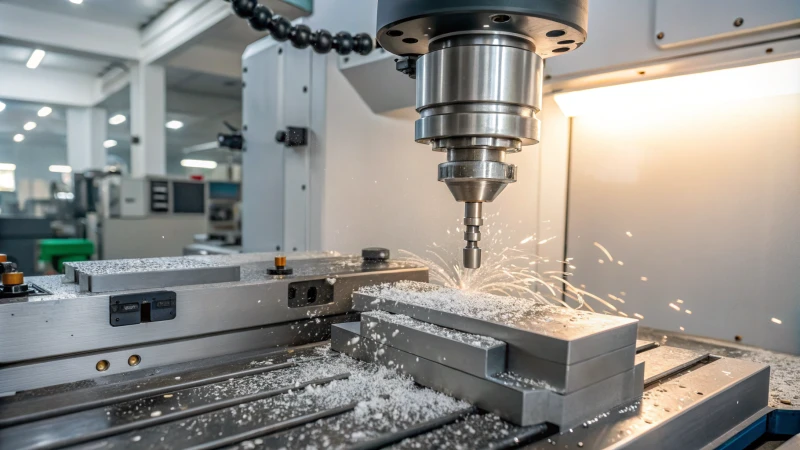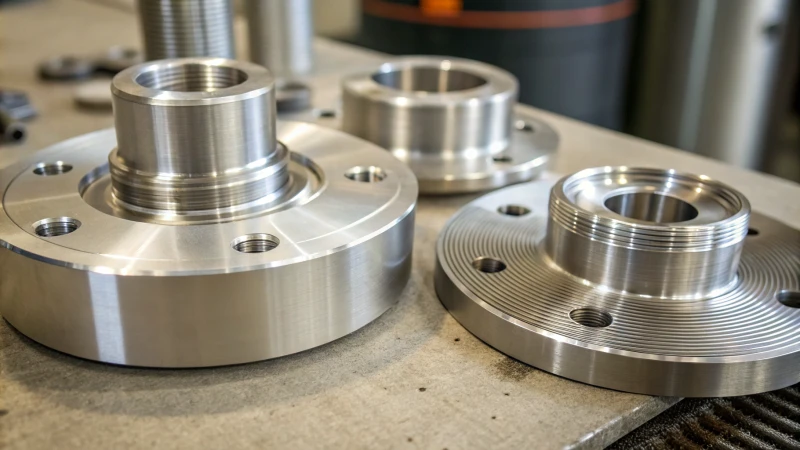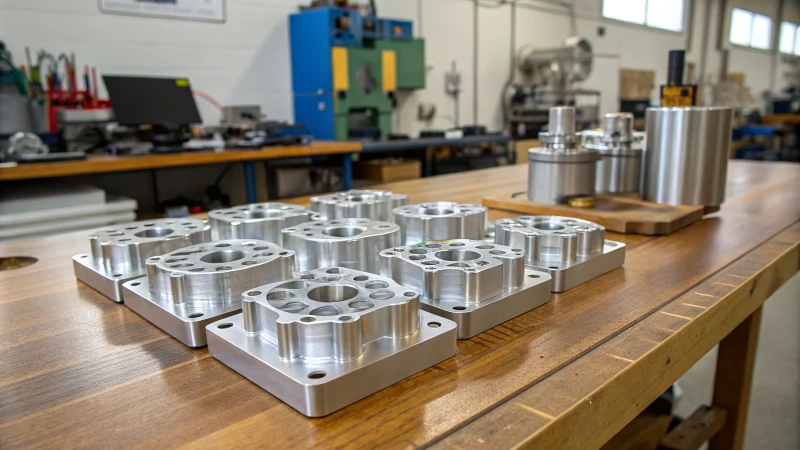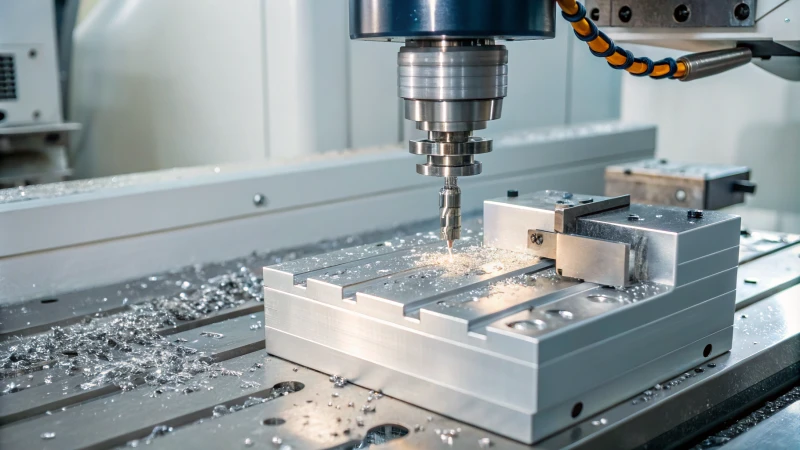What Are the Benefits of CNC Milling 6061-T6 Aluminum Parts?

CNC milling of 6061-T6 aluminum is revolutionizing the manufacturing landscape.
CNC milling of 6061-T6 aluminum parts offers unparalleled precision, strength, and versatility, making it an ideal choice for various applications in industries like aerospace and automotive. Its excellent machinability allows for complex designs while ensuring tight tolerances and durability.
In this blog post, we’ll delve deeper into the specific advantages of CNC milling for 6061-T6 aluminum parts, explore key machining processes, and provide insights on how to choose the right suppliers for your needs.
CNC milling enhances precision in aluminum part manufacturing.True
CNC milling significantly improves the precision of machining 6061-T6 aluminum, ensuring accurate dimensions and tight tolerances for various applications.
6061-T6 aluminum is unsuitable for aerospace applications.False
Contrary to this claim, 6061-T6 aluminum is widely used in aerospace due to its strength and lightweight properties, making it highly suitable for such applications.
What Makes 6061-T6 Aluminum a Preferred Choice for CNC Milling?
Understanding the unique properties of 6061-T6 aluminum is essential for manufacturers seeking durable and high-performance materials for CNC milling. What sets this alloy apart?
6061-T6 aluminum is preferred for CNC milling due to its excellent strength, corrosion resistance, and machinability. Ideal for complex designs, it provides tight tolerances and durability for various applications.

Strength and Durability of 6061-T6 Aluminum
6061-T6 aluminum is renowned for its high strength-to-weight ratio. This alloy can sustain significant loads while remaining lightweight, making it an ideal choice for applications where weight savings are crucial. For example, in the aerospace industry, where every gram counts, using 6061-T6 can enhance overall efficiency.
| Property | Value |
|---|---|
| Yield Strength | 276 MPa |
| Ultimate Tensile Strength | 310 MPa |
| Density | 2.70 g/cm³ |
The temper designation of T6 indicates that the alloy has been solution heat-treated and artificially aged, resulting in enhanced mechanical properties that offer longevity and reliability in demanding environments.
Corrosion Resistance
One of the standout features of 6061-T6 is its excellent corrosion resistance. This property is vital for components exposed to harsh weather conditions or corrosive environments, such as marine applications. The alloy forms a protective oxide layer that significantly slows down corrosion processes, ensuring that parts last longer and require less maintenance.
You can learn more about corrosion resistance in aluminum alloys and how it impacts material selection.
Machinability
6061-T6 aluminum is highly machinable, allowing for intricate designs and precise tolerances. CNC milling processes can achieve tight dimensional specifications, often reaching tolerances of ±0.01mm or better. This level of precision is crucial when manufacturing components that must fit together seamlessly in larger assemblies.
Furthermore, the alloy’s favorable machinability means that it can be processed at higher speeds, which can lead to reduced production times and costs. For detailed guidelines on machining techniques, check out this resource on effective CNC milling strategies.
Versatility in Applications
6061-T6 aluminum is versatile, with applications ranging from automotive parts to structural components in buildings. Its ability to be welded without losing strength makes it a preferred choice for fabricating complex assemblies. Additionally, the alloy can be anodized for aesthetic appeal and enhanced surface protection.
Common Applications of 6061-T6 Aluminum:
- Aerospace Components
- Automotive Parts
- Marine Structures
- Sporting Goods
For insights on specific applications, explore this article on aluminum alloys in various industries.
Cost-Effectiveness
While the initial cost of CNC machining parts from 6061-T6 may be higher than lower-grade alloys, the long-term value often outweighs these initial expenditures. The durability and reduced maintenance needs associated with this alloy lead to overall cost savings in many applications. It’s essential to weigh these factors when selecting materials for your projects.
Discover more about cost management in CNC machining to ensure you’re making informed financial decisions regarding material use.
6061-T6 aluminum has a high strength-to-weight ratio.True
This alloy's impressive strength-to-weight ratio makes it ideal for applications requiring lightweight yet durable materials, such as aerospace.
6061-T6 aluminum is not corrosion resistant.False
Contrary to this claim, 6061-T6 aluminum exhibits excellent corrosion resistance, crucial for marine and harsh environments.
How Does CNC Milling Enhance the Machinability of Aluminum Parts?
CNC milling revolutionizes the machining process for aluminum parts by enhancing precision, efficiency, and design flexibility. But how exactly does it achieve these improvements?
CNC milling improves the machinability of aluminum parts by providing high precision, enabling complex geometries, and reducing production time. This results in durable, high-quality components suitable for demanding industries.

The Role of CNC Milling in Machining Aluminum
CNC milling significantly enhances the machinability of aluminum parts by utilizing computer-controlled precision to achieve exact specifications. This process allows for the creation of complex geometries that are often challenging to produce with traditional machining methods.
For instance, intricate designs for aerospace components can be easily programmed into CNC machines, resulting in higher efficiency and reduced error rates. The combination of high-speed machining and precise control ensures that even the most detailed features are accurately replicated.
Moreover, CNC milling minimizes human error, which is a common issue in manual machining processes. With consistent tool paths and settings, manufacturers can achieve greater reliability in their production outcomes. This is especially important in industries where safety and performance are paramount, such as automotive and aerospace.
Material Compatibility
6061-T6 aluminum, a popular choice in CNC milling, benefits from this technology due to its excellent machinability. This alloy is designed to withstand significant stress while being easy to cut and shape, which is essential for high-precision applications.
| Feature | 6061-T6 Aluminum | CNC Milling Benefits |
|---|---|---|
| Strength | High | Enables durable component production |
| Corrosion Resistance | Excellent | Reduces maintenance needs |
| Workability | Easy to machine | Facilitates complex designs |
Precision and Accuracy
One of the main advantages of CNC milling is its ability to maintain tight tolerances. For instance, parts can be produced with tolerances as tight as ±0.01mm. This level of precision is crucial for applications where even minor deviations can lead to failure or malfunction.
CNC milling not only improves the accuracy of finished parts but also ensures consistency across multiple batches. This reliability is vital for manufacturers looking to scale production while maintaining quality standards.
Reduced Production Time
CNC milling streamlines the manufacturing process by allowing for rapid prototyping. Designers can quickly create and test prototypes, which can significantly reduce the time it takes to bring a product to market.
The ability to rapidly iterate on designs means companies can respond faster to market demands and innovate without excessive delays. This agility can give businesses a competitive edge in fast-paced industries.
Surface Finish and Quality Control
The surface finish achieved through CNC milling is often superior compared to traditional methods. Properly configured CNC machines produce parts with smooth surfaces and minimal tool marks.
To ensure high-quality output, manufacturers often implement quality control checks throughout the milling process. This approach not only verifies that the parts meet specifications but also helps identify any potential issues before they escalate.
For further insights into optimizing your CNC milling processes, consider exploring best practices in CNC machining. With the right knowledge and tools, manufacturers can harness the full potential of CNC technology to enhance the machinability of aluminum parts effectively.
CNC milling reduces human error in aluminum machining processes.True
By utilizing computer-controlled precision, CNC milling minimizes the chances of human mistakes, enhancing overall production reliability.
6061-T6 aluminum is difficult to machine with CNC technology.False
Contrary to this claim, 6061-T6 aluminum is known for its excellent machinability, making it ideal for CNC milling applications.
What Are the Common Applications of CNC-Milled 6061-T6 Aluminum Parts?
CNC-milled 6061-T6 aluminum parts are integral in various industries due to their superior properties. But where exactly are they applied?
CNC-milled 6061-T6 aluminum parts are widely used in aerospace, automotive, medical equipment, industrial machinery, and consumer goods due to their high strength, lightweight, and excellent machinability.

Aerospace Applications
CNC-milled 6061-T6 aluminum parts are extensively used in the aerospace industry due to their high strength-to-weight ratio. Components such as brackets, frames, and structural parts are commonly fabricated from this alloy. The need for precision is critical in aerospace applications, making CNC milling an ideal choice for producing parts that must endure extreme conditions.
For example, aircraft components must not only be lightweight but also capable of withstanding high stress and environmental factors. This is where the properties of 6061-T6 shine, as it offers excellent fatigue resistance and durability, essential for parts like wing supports and engine mounts.
- Key Benefits: High strength, low weight, corrosion resistance.
Automotive Applications
In the automotive sector, CNC-milled 6061-T6 aluminum is favored for creating parts that contribute to vehicle performance and aesthetics. Common applications include:
| Component Type | Description |
|---|---|
| Chassis Parts | Provides structural integrity while minimizing weight. |
| Engine Components | Ideal for components that require strength and heat resistance. |
| Custom Accessories | Lightweight and durable options for aftermarket modifications. |
The automotive industry values the machinability of 6061-T6, allowing for intricate designs that enhance both functionality and appearance. Explore more automotive applications.
Medical Equipment
CNC-milled 6061-T6 aluminum is also a prominent material in the medical field, where precision and reliability are paramount. Applications include:
- Surgical Instruments: The alloy’s strength ensures durability while maintaining a lightweight structure for ease of use.
- Medical Device Housings: These housings require both structural integrity and a finish that meets stringent hygienic standards.
The ability to produce complex geometries with tight tolerances makes 6061-T6 an ideal choice for critical medical components. Discover more about medical applications.
Industrial Machinery
In industrial settings, CNC-milled 6061-T6 aluminum parts are utilized in various machinery and equipment. Some common applications include:
| Application | Benefits |
|---|---|
| Machine Components | High strength ensures longevity and reliability. |
| Fixtures and Jigs | Precision helps in the manufacturing process. |
| Conveyor Systems | Lightweight design improves efficiency. |
The versatility of 6061-T6 aluminum allows manufacturers to create custom solutions tailored to specific industrial needs. Learn more about industrial applications.
Consumer Goods
Finally, CNC-milled 6061-T6 aluminum is found in numerous consumer products, particularly those requiring lightweight yet robust materials. Examples include:
- Outdoor Equipment: From camping gear to bike frames, the alloy is favored for its durability in outdoor conditions.
- Electronics Enclosures: Provides protection while maintaining an attractive appearance.
The aesthetic appeal combined with functional properties makes 6061-T6 a popular choice among designers of consumer goods. View consumer product applications.
CNC-milled 6061-T6 aluminum is used in aerospace components.True
Due to its high strength-to-weight ratio, 6061-T6 aluminum is ideal for critical aerospace parts like brackets and engine mounts.
6061-T6 aluminum is unsuitable for medical instruments.False
On the contrary, its strength and lightweight properties make 6061-T6 a preferred choice for durable surgical instruments.
What Challenges Should You Expect When CNC Milling 6061-T6 Aluminum?
CNC milling of 6061-T6 aluminum presents several challenges that can impact the machining process and final product quality.
When CNC milling 6061-T6 aluminum, expect challenges such as chatter, built-up edge, and heat management issues that can affect precision and surface finish.

1. Understanding Common Challenges
When CNC milling 6061-T6 aluminum, machinists often encounter specific challenges that can affect the quality of the final product. One of the most common issues is chatter, which can lead to a poor surface finish and dimensional inaccuracies. To mitigate this, it is important to adjust the cutting parameters such as feed rate and spindle speed.
Another prevalent issue is the built-up edge (BUE), which occurs when material accumulates on the cutting tool due to excessive heat generated during machining. This can cause inconsistent cuts and tool wear. Utilizing appropriate cutting fluids and selecting the right tool geometry can help reduce BUE.
2. Heat Management
6061-T6 aluminum is known for its excellent machinability, but heat generation can still be a significant problem during CNC milling. If temperatures rise too high, it can lead to thermal deformation and impact the part’s tolerances. To manage heat effectively:
- Use of Coolants: Employing coolants or cutting fluids can significantly reduce temperatures and improve tool life.
- Tool Material Selection: Choosing carbide tools can withstand higher temperatures compared to high-speed steel (HSS) tools, enhancing performance.
3. Dimensional Tolerances
Maintaining tight tolerances is crucial in CNC milling. For parts made from 6061-T6 aluminum, achieving ±0.01mm precision is often necessary. Here are key considerations:
| Tolerance Level | Recommended Practices |
|---|---|
| ±0.01mm | Regular calibration of CNC machinery, use of precise measuring tools |
| ±0.05mm | Thorough inspection protocols, quality control measures |
4. Tool Wear and Maintenance
Tool wear is an inevitable part of the CNC milling process, especially when working with materials like 6061-T6 aluminum. Machinists should be aware of:
- Regular Inspection: Frequent checks on tool condition can prevent unexpected failures during machining.
- Using Coated Tools: Consider using tools with special coatings that enhance wear resistance and reduce friction.
5. Surface Finish Quality
The surface finish of machined parts is critical for both aesthetic and functional purposes. Achieving a smooth finish requires attention to detail:
- Cutting Speed Optimization: Adjusting cutting speeds based on the tooling and material properties can minimize tool marks.
- Post-Processing Techniques: Employing techniques such as anodizing or polishing can enhance surface quality after milling.
6. Supplier Communication
Working with suppliers who understand the specific requirements for machining 6061-T6 aluminum is essential for overcoming challenges:
- Clear Design Specifications: Provide detailed designs to ensure suppliers comprehend your requirements fully.
- Feedback Mechanisms: Establishing robust communication channels for feedback can help address issues promptly and lead to improved outcomes.
By considering these factors, machinists can better prepare for the challenges that arise during CNC milling of 6061-T6 aluminum, ensuring higher quality results for their projects.
Chatter can affect the surface finish in CNC milling.True
Chatter is a common issue in CNC milling that leads to poor surface quality and inaccuracies, making it a significant challenge when working with 6061-T6 aluminum.
Coolants are unnecessary for machining 6061-T6 aluminum.False
Using coolants is crucial for managing heat during CNC milling of 6061-T6 aluminum, as excessive heat can lead to thermal deformation and impact tolerances.
How Can You Select the Right Supplier for CNC Milling Projects?
Finding the right supplier for CNC milling projects can make all the difference in achieving high-quality results and maintaining project timelines.
To select the right supplier for CNC milling projects, assess their experience, quality control measures, communication skills, cost transparency, and potential for a long-term partnership.

Understanding Your Project Needs
Before you even start looking for a supplier, it’s crucial to define your project requirements. Consider factors like
- Material Specifications: What materials will be used?
- Dimensional Tolerances: What are the required tolerances for the parts?
- Volume Requirements: How many parts do you need?
Understanding these factors will help you filter suppliers that can meet your specific needs. For example, if you’re working with 6061-T6 aluminum, ensure your supplier has experience in milling this material.
Evaluating Supplier Experience and Capabilities
| Once you have defined your project needs, evaluate potential suppliers based on their experience and capabilities. Here are some criteria to consider: | Criteria | What to Look For |
|---|---|---|
| Industry Experience | Look for suppliers with a proven track record in your industry. | |
| Technical Expertise | Ensure they have skilled machinists and engineers. | |
| Technology and Equipment | Check if they use advanced CNC machines suitable for your requirements. |
Engaging with suppliers who understand the nuances of CNC milling will significantly enhance the quality of your output.
Assessing Quality Control Measures
Quality assurance is paramount in CNC milling projects. Suppliers should have rigorous quality control processes in place to ensure the parts meet specifications. Ask about their quality control systems and certifications:
- ISO Certifications: An ISO-certified supplier usually adheres to high standards.
- Inspection Processes: Inquire about their inspection methods and frequency of checks during production.
A reliable supplier should be able to demonstrate their commitment to quality through documented processes and past performance metrics.
Importance of Communication and Support
Effective communication is essential for a successful partnership. Assess how responsive and supportive a supplier is during initial discussions:
- Initial Response Time: How quickly do they respond to inquiries?
- Technical Support: Are they willing to provide assistance with design modifications or tooling suggestions?
- Regular Updates: Do they keep you informed about production progress and any potential issues?
A supplier that values clear communication can help mitigate risks throughout the manufacturing process.
Cost Considerations and Transparency
While cost is a significant factor, it shouldn’t be the only one. Be wary of suppliers who offer significantly lower prices without clear reasoning; this might indicate compromised quality. Instead, consider:
- Total Cost of Ownership: Factor in not just the upfront costs but also potential long-term savings from high-quality, durable parts.
- Transparent Pricing Models: Ensure the pricing structure is clear and includes details on any additional fees, such as setup or tooling costs.
Evaluating these aspects can lead to better financial decisions for your project.
Building a Long-Term Relationship
Lastly, consider the potential for a long-term partnership. Suppliers who are invested in understanding your business can provide better service over time. Look for:
- Flexibility: Can they adapt to changing requirements?
- Reliability: Do they consistently deliver on time?
- Innovation: Are they open to exploring new technologies and techniques that could benefit your projects?
Choosing a supplier is not just about immediate needs but also about finding a partner that aligns with your long-term goals.
Supplier experience directly impacts project quality.True
Experienced suppliers understand CNC milling nuances, ensuring better quality outcomes for projects.
Lower cost suppliers guarantee high-quality parts.False
Choosing suppliers solely based on lower costs can lead to compromised quality in CNC milling projects.
Conclusion
CNC milling 6061-T6 aluminum offers high precision, strength, and versatility for various applications, making it ideal for demanding industries like aerospace and automotive.


